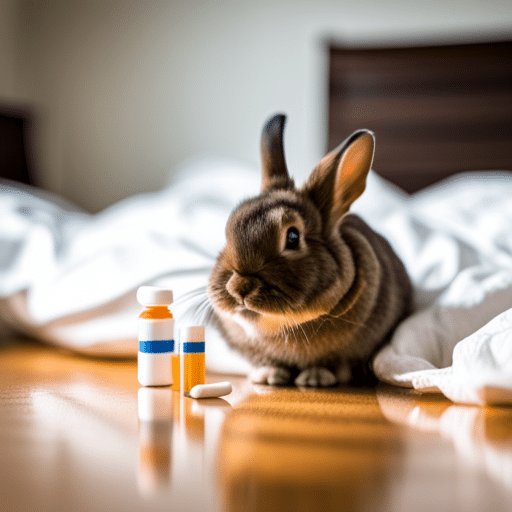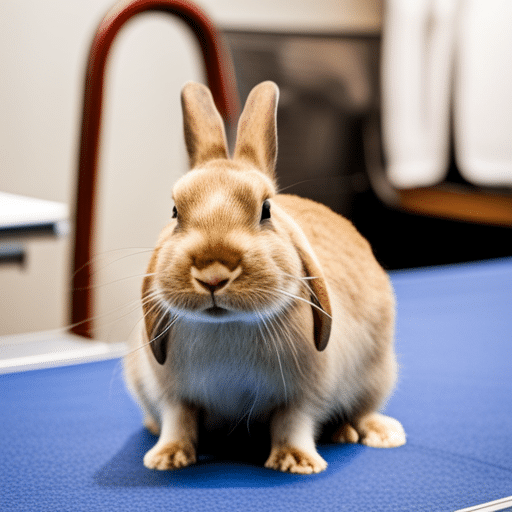Imagine noticing your beloved pet rabbit can’t move its back legs, and your heart sinks as you realize something is wrong. Hind leg issues in rabbits can be caused by various factors, and it is essential to understand how to recognize, prevent, and manage these problems. In this blog post, we will explore the different types of hind leg weakness and paralysis in pet rabbits, their causes, diagnostic tests, treatment options, and supportive care to ensure the well-being of your furry friend.
Short Summary
Recognize hind leg weakness and paralysis in pet rabbits, and investigate underlying causes for proper treatment.
Prevent and manage hind leg issues with regular checkups, healthy diet & exercise, and safe handling techniques.
Provide supportive care to maintain comfort & quality of life. Create a comfortable living space with soft bedding.
Recognizing Hind Leg Weakness and Paralysis in Pet Rabbits

As a rabbit owner, it’s important to be vigilant and monitor your pet for any signs of hind legs falling or leg issues. Hind leg weakness and paralysis can manifest in different ways, such as difficulty standing up, unsteadiness when standing, dragging feet when moving, or a slanting hind end.
These conditions can be caused by a variety of factors, including spinal cord injuries, brain and spinal cord diseases, and E. cuniculi infection.
Hind Leg Weakness
Hind leg weakness in rabbits can result from several causes, such as arthritis, spondylosis, and even neurological disorders like Floppy Rabbit Syndrome (FRS). Age-related issues like arthritis and spondylosis are common contributors to hind leg weakness.
In some cases, hind leg weakness may also be caused by infections like bumblefoot, a bacterial infection that leads to sores on the hock. Diagnosing the cause of hind leg weakness is crucial for determining the appropriate treatment plan.
Partial Paralysis
Partial paralysis in rabbits may affect one or more limbs, impacting their balance and coordination. Possible causes include degenerative processes, inflammatory diseases, or even vertebral fractures or luxations.
Diagnostic tests like radiographs, myelography, or computed tomography can help identify the underlying cause of partial paralysis.
Complete Paralysis
Complete paralysis occurs when a rabbit can no longer move its hind legs due to a severed spinal cord. This condition can be caused by severe spinal injuries or diseases like E. cuniculi.
If your rabbit exhibits signs of partial or complete paralysis, it’s crucial to seek immediate veterinary attention to determine the cause and initiate appropriate treatment.
Investigating the Causes of Hind Leg Issues
Understanding the potential causes of hind leg issues in rabbits is essential for effective treatment. A variety of factors, such as spinal cord injuries, brain and spinal cord diseases, and E. cuniculi infection, can lead to hind leg problems. It’s crucial to identify the underlying cause of your rabbit’s hind leg issue, as this will help determine the best course of action for treatment and management.
Birth defects, injuries, and neurological diseases can also contribute to hind leg issues in rabbits. In some cases, age-related diseases like arthritis or spondylosis of the lumbar spine can cause weakness or paralysis in pet rabbits. Early detection and intervention are key to preventing further complications and ensuring the well-being of your pet rabbit.
Spinal Cord Injuries
Spinal cord injuries can result from various causes, such as trauma or degenerative changes in the spine. These injuries can lead to hindlimb paresis or paralysis, difficulty in movement, and other complications like urinary and fecal incontinence, urine scalding, and skin ulcers.
Prompt diagnosis and treatment are essential to mitigate the impact of spinal cord injuries on your rabbit’s quality of life.
Brain and Spinal Cord Diseases
Brain and spinal cord diseases, such as encephalitozoon cuniculi (E. cuniculi), can cause hind leg weakness or paralysis in rabbits. These diseases can result in symptoms like head tilt, seizures, and alterations in behavior.
Diagnosing brain and spinal cord diseases may involve a physical examination, radiographs, or even advanced imaging techniques like computed tomography (CT) and magnetic resonance imaging (MRI).
E. Cuniculi Infection
E. cuniculi infection, caused by the Encephalitozoon cuniculi fungus, is a common cause of hindlimb paralysis in pet rabbits. This parasitic infection can lead to the destruction of nervous tissue, resulting in symptoms like head tilt, tremors, kidney problems, and hindlimb paralysis.
While diagnosing E. cuniculi can be challenging, early treatment with medications like fenbendazole can help manage the symptoms.
Diagnostic Tests for Hind Leg Problems
To accurately diagnose your rabbit’s hind leg issue, various diagnostic tests may be necessary. These tests can include X-rays, CT scans, MRI scans, and blood tests. Each test provides valuable information to help your veterinarian determine the underlying cause of your rabbit’s hind leg problem and recommend the most appropriate treatment plan.
In some cases, such as suspected E. cuniculi infection, blood tests can be instrumental in confirming the diagnosis. Accurate diagnosis is essential to ensure that your rabbit receives the most effective treatment, improving its chances of recovery and maintaining a good quality of life.
Treatment Options for Rabbits with Hind Leg Issues
Once your rabbit’s hind leg issue has been diagnosed, your veterinarian will recommend the most suitable treatment plan, which may include medications, physical therapy, or surgical interventions. The treatment approach will depend on the underlying cause of the hind leg issue and the severity of the problem.
Early intervention and appropriate treatment are vital to improving your rabbit’s quality of life and preventing further complications.
Medications

Medications such as anti-inflammatory drugs and pain relief can be prescribed by your veterinarian to manage your rabbit’s hind leg issue. For example, meloxicam, a non-steroidal anti-inflammatory drug (NSAID), is often prescribed to alleviate inflammation and provide pain relief for rabbits with hind leg issues.
In the case of E. cuniculi infection, a 28-day course of fenbendazole can be administered to help manage the symptoms.
Physical Therapy
Physical therapy can be an essential component of your rabbit’s treatment plan. Exercises designed to strengthen muscles, improve coordination, and gently flex and extend the joints can promote healing and recovery. Techniques like the “meatloaf” position for rabbits with hind leg weakness or paralysis can help stretch the hind legs and prevent stiffness.
Your veterinarian may provide guidance on appropriate physical therapy exercises for your rabbit’s specific condition.
Surgical Interventions
In some cases, surgical interventions may be necessary to address your rabbit’s hind leg issue, especially when spinal injuries are severe and other treatment options have been exhausted.
Surgical procedures like spinal fusion, laminectomy, and decompression can be performed to alleviate pressure on the spinal cord and improve your rabbit’s mobility and quality of life.
Supportive Care for Rabbits with Hind Leg Weakness or Paralysis

In addition to medical treatment, providing supportive care for rabbits with hind leg weakness or paralysis is crucial for their well-being. This includes measures such as preventing pressure sores, assisting with bladder and bowel control, and creating a comfortable living space for your rabbit. By addressing these aspects of your rabbit’s care, you can help ensure their comfort and improve their overall quality of life.
Preventing Pressure Sores
Pressure sores can develop in rabbits with hind leg weakness or paralysis due to prolonged periods of immobility. To prevent these sores, ensure your rabbit has adequate cushioning and rotate their position 4-10 times per day. Applying a barrier cream to the rabbit’s hind legs can also help protect against pressure sores.
Maintaining a healthy weight and keeping your rabbit’s nails trimmed can further reduce the risk of pressure sores.
Assisting with Bladder and Bowel Control
Rabbits with hind leg issues may struggle with bladder and bowel control. Providing a low-entry litter box can make it easier for your rabbit to access their bathroom area. Ensuring your rabbit has a high-fiber diet can also aid in maintaining regular bowel movements.
In some cases, you may need to manually express your rabbit’s bladder to help them evacuate urine. Consult with your veterinarian for guidance on how to assist your rabbit with bladder and bowel control safely.
Creating a Comfortable Living Space
Creating a comfortable living environment is essential for rabbits with hind leg weakness or paralysis. Provide a spacious and secure area with soft, absorbent bedding to help alleviate pressure on your rabbit’s body. Monitor the temperature in your rabbit’s living space to ensure they remain comfortable, and make any necessary modifications to accommodate their unique needs.
By providing a nurturing and supportive environment, you can help your rabbit thrive despite their hind leg issues.
Prevention and Management of Hind Leg Issues in Pet Rabbits
Preventing and managing hind leg issues in pet rabbits involves a combination of regular checkups, proper diet and exercise, and safe handling techniques. By adhering to these practices, you can help reduce the risk of hind leg problems in your pet rabbit, ensuring they lead a healthy and happy life.
Regular Checkups
Scheduling regular checkups with a veterinarian who specializes in rabbits is crucial for early detection of any health issues. These checkups should be conducted at least once a year, or more frequently if your rabbit has existing health issues.
Early intervention can help prevent more severe health complications and improve your rabbit’s overall well-being.
Proper Diet and Exercise
Maintaining a proper diet and ensuring your rabbit gets sufficient exercise can help prevent hind leg issues. Provide your rabbit with a balanced diet consisting of hay or grass, green plants, and a small amount of high-quality rabbit food.
Ensure your rabbit receives at least 4 hours of exercise daily, including activities like hopping, running, and jumping. A healthy diet and regular exercise can help prevent weight gain, which can exacerbate hind leg issues such as arthritis.
Safe Handling Techniques

Using safe handling techniques when interacting with your rabbit can help prevent injuries that may lead to hind leg issues. Avoid lifting your rabbit by its ears or rear legs, as this can cause harm. Instead, grasp your rabbit gently by the scruff of its neck or use a towel wrapped around its body for restraint.
Proper handling can help ensure your rabbit remains safe and comfortable during interactions.
Summary
In conclusion, hind leg weakness and paralysis in pet rabbits can be caused by various factors, such as spinal cord injuries, brain and spinal cord diseases, and E. cuniculi infection. By recognizing the signs of hind leg issues, understanding their causes, and seeking appropriate diagnostic tests and treatment options, you can help ensure the well-being of your pet rabbit. Additionally, providing supportive care, implementing preventive measures, and managing your rabbit’s environment can contribute to a healthier and happier life for your furry friend.
Frequently Asked Questions
How do you treat a rabbit with hind leg paralysis?
If a rabbit is suffering from hind leg paralysis, it is essential to seek immediate veterinary attention. Treatment may include pain relief, reduced movement in the affected area, cage rest, and anti-inflammatory medications.
In some cases, surgery may be necessary to release pressure on the spinal cord.
Why is my rabbit not able to walk?
It appears that my rabbit is unable to walk due to a combination of potential causes such as pododermatitis, arthritic conditions, cancer, spinal osteoarthritis, parasitic, bacterial, and fungal infections, and hind limb paresis and paralysis.
These conditions can be caused by a variety of factors, including genetics, diet, environment, and trauma. Treatment options vary depending on the underlying cause but may include antibiotics, anti-inflammatory medications, physical therapy, and surgery.
It is important to consult with a veterinarian to determine the best course of action for your pet. With the right care.
How long does it take for a rabbit to recover from paralysis?
Recovery from paralysis in rabbits can take anywhere from a few days to several months, depending on the severity of the injury.
With careful care and anti-inflammatory medications to reduce damage due to swelling, your rabbit should be able to make a full recovery with time and patience.
What are the signs of back injury in rabbits?
Signs of back injury in rabbits include reluctance to place even pressure on their hind limbs, reduced range of motion of their neck and back, not responding to touch over a paralyzed area, exaggerated reflexes or spasms, rapid labored breathing, being withdrawn, decreased appetite, and incontinence with fecal/urine soiling of the fur.
These signs can be indicative of a serious injury, and it is important to seek veterinary care as soon as possible. Treatment may include pain relief, physical therapy, and in some cases, surgery. With prompt and appropriate care, rabbits can make a full recovery from back injuries.



